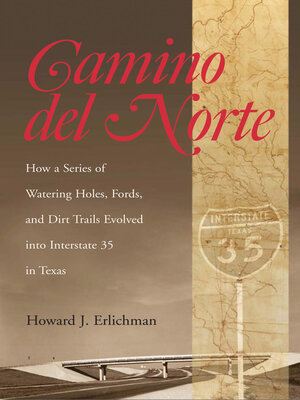Camino del Norte
ebook ∣ How a Series of Watering Holes, Fords, and Dirt Trails Evolved into Interstate 35 in Texas · Centennial Series of the Association of Former Students, Texas A&M University
By Howard J. Erlichman

Sign up to save your library
With an OverDrive account, you can save your favorite libraries for at-a-glance information about availability. Find out more about OverDrive accounts.
Find this title in Libby, the library reading app by OverDrive.



Search for a digital library with this title
Title found at these libraries:
| Library Name | Distance |
|---|---|
| Loading... |
Some five hundred miles of superhighway run between the Rio Grande and the Red River—present-day Interstate 35. This towering achievement of modern transportation engineering links a string of Texas metropolises and some 7.7 million people, and yet it all evolved from a series of humble little trails.
The I-35 Corridor that runs north-south through Texas connects Dallas and Fort Worth with Austin, San Antonio, and Laredo en route to ancient towns in Mexico. Along its path lie urban centers, technology parks, parking lots, strip malls, apartment complexes, and vast open spaces. In this fascinating popular history, based on extensive primary and secondary research, Howard J. Erlichman asks how and why the Camino del Norte (the Northern Road) developed as (and where) it did. He uncovers, dissects, prioritizes, and repackages layer upon layer of centuries-spanning history to, in his words, "solve the mystery of I-35."
His chronicle focuses less on the physical placement of I-35 than on the reasons it was created: the founding of posts and villages and the early development of towns. Along the way, he explores a number of circumstances that contributed to the location and development of the corridor: pre-Columbian cultures, Mexican silver mining, road and bridge building techniques, Indian tribes, railroad developments, military affairs, car culture, and pavement technology, to name a few.
Presently, a variety of new highway projects are underway to address the dramatic expansion of I-35 traffic generated by population growth and business enterprise. Those interested in the economic development of the state of Texas, in NAFTA links and their precursors, and in touring the Interstate itself will find this book informative and useful.
The I-35 Corridor that runs north-south through Texas connects Dallas and Fort Worth with Austin, San Antonio, and Laredo en route to ancient towns in Mexico. Along its path lie urban centers, technology parks, parking lots, strip malls, apartment complexes, and vast open spaces. In this fascinating popular history, based on extensive primary and secondary research, Howard J. Erlichman asks how and why the Camino del Norte (the Northern Road) developed as (and where) it did. He uncovers, dissects, prioritizes, and repackages layer upon layer of centuries-spanning history to, in his words, "solve the mystery of I-35."
His chronicle focuses less on the physical placement of I-35 than on the reasons it was created: the founding of posts and villages and the early development of towns. Along the way, he explores a number of circumstances that contributed to the location and development of the corridor: pre-Columbian cultures, Mexican silver mining, road and bridge building techniques, Indian tribes, railroad developments, military affairs, car culture, and pavement technology, to name a few.
Presently, a variety of new highway projects are underway to address the dramatic expansion of I-35 traffic generated by population growth and business enterprise. Those interested in the economic development of the state of Texas, in NAFTA links and their precursors, and in touring the Interstate itself will find this book informative and useful.







